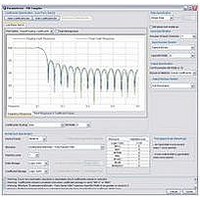IPR-FIR Altera, IPR-FIR Datasheet - Page 57

IPR-FIR
Manufacturer Part Number
IPR-FIR
Description
IP CORE Renewal Of IP-FIR
Manufacturer
Altera
Type
MegaCorer
Specifications of IPR-FIR
Software Application
IP CORE, DSP Filters And Transforms
Supported Families
Arria GX, Arria II GX, Cyclone, HardCopy, Stratix
Core Architecture
FPGA
Core Sub-architecture
Arria, Cyclone, Stratix
Rohs Compliant
NA
Function
Finite Impulse Response Compiler
License
Renewal License
Lead Free Status / RoHS Status
na
Lead Free Status / RoHS Status
na
Chapter 4: Functional Description
Avalon Streaming Interface
Figure 4–12. Avalon-ST Interface Timing with READY_LATENCY=0
Figure 4–13. Packet Data Transfer
© December 2010 Altera Corporation
1
startofpacket
channel[1:0]
endofpacket
ready
error
error[1:0]
valid
data
clk
ready
The sink indicates to the source that it is ready for an active cycle by asserting the
ready signal for a single clock cycle. Cycles during which the sink is ready for data
are called ready cycles. During a ready cycle, the source may assert valid and provide
data to the sink. If it has no data to send, it deasserts valid and can drive data to any
value.
When READY_LATENCY=0, data is transferred only when ready and valid are
asserted on the same cycle. In this mode of operation, the source data does not need to
receive the sink’s ready signal before it begins sending valid data. The source
provides the data and asserts valid whenever it can and waits for the sink to capture
the data and assert ready. The sink only captures input data from the source when
ready and valid are both asserted.
Figure 4–12
The source provides data and asserts valid on cycle 1, even though the sink is not
ready. The source waits until cycle 2, when the sink does assert ready, before moving
onto the next data cycle. In cycle 3, the source drives data on the same cycle and
because the sink is ready to receive it, the transfer occurs immediately. In cycle 4, the
sink asserts ready, but the source does not drive valid data.
Packet Data Transfers
A beat is defined as the transfer of one unit of data between a source and sink
interface. This unit of data may consist of one or more symbols and makes it is
possible to support modules that convey more than one piece of information about
each valid cycle. Packet data transfers are used for multichannel transfers. Two
additional signals (startofpacket and endofpacket) are defined to implement
the packet transfer.
Figure 4–13
data sample belongs.
The channel input signal is not used in the FIR Compiler interface.
valid
data
clk
0
illustrates the data transfer timing.
shows an example where the channel signal shows to which channel the
1
1
D
00
0
0
00
D
2
2
o
00
D
1
1
3
3
00
D
1
4
4
D
00
2
2
5
5
00
D
00
D
3
6
3
2
6
7
00
D
2
7
8
FIR Compiler User Guide
4–15















